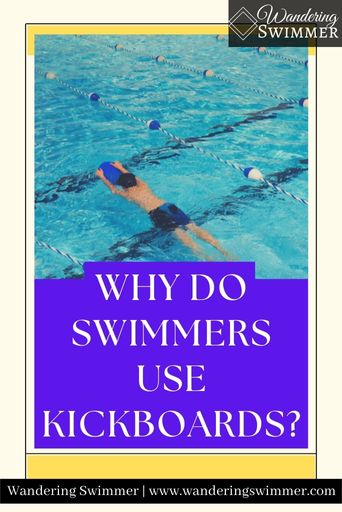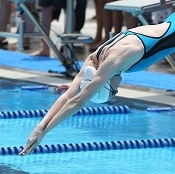Kickboards are a common piece of swimming equipment found at the pool. They’re easy to use and can provide a great workout for anyone. But why do swimmers use kickboards? Is there a specific purpose to them that makes them so important?
And the answer is that, yes, there is!
A kickboard offers more than just a break from swimming laps and a chance to be social during practice. It’s designed to make swimmers focus and work on improving an important piece of their stroke.
And while most swimmers enjoy ‘social kicking’ with their kickboards, this piece of equipment is more than just a social tool.
Disclosure: This post may contain affiliate links, meaning we earn a small commission at no cost to you if you purchase something through one of our links. As an Amazon Associate, we earn from qualifying purchases. Please check out our disclosure page for more information

Benefits to Swimmers Using Kickboards
Forces Swimmers to Kick
It seems a bit silly to say it, but swimmers use kickboards to, well, kick! For some swimmers though, it’s more that it forces them to kick
Some swimmers fall into the habit of using only their arms to help propel them forward, instead of using both kick and stroke. This isn’t necessarily a bad thing, of course!
Related article: The Best 11 Kickboards for Swimmers
Watch any distance swimmer and you’ll see that they kick very minimally compared to sprinters and mid-distance swimmers. But even distance swimmers pick up their kick as they reach their final few laps.
For those swimmers who rely specifically on their pull to move forward, the kickboard forces them to use their legs instead. Their arms have to hold the kickboard out in front of them instead of using them to stroke.
Simple in nature but very effective.
Develops Proper Kicking Technique
Swimming is all about proper technique.
One of the common errors swimmers make with the freestyle kick is kicking with their knees. Either through kicking from the knee down (resulting in tons of splashing). Or, by dropping their knees and trying to push them up/through the water. Much like peddling a bicycle.
Swimmers use kickboards to help correct these mistakes. From the deck, coaches can see when a swimmer isn’t kicking correctly and work to point these out.
This same approach works with the butterfly kick.
Too often, swimmers will try to kick more with their knees instead of with their hips. And while a kickboard can hamper some of the motions of the butterfly kick, it’s still a useful aid to develop a proper kicking technique.
More Content for You: Can You Swim With Long Hair?
We should note though that sometimes a kickboard can hamper a butterfly kick. The board reduces the ability to utilize the torso to start the kick. For some people, this is an issue. Other swimmers can power through it.
Builds Leg Strength
It’s probably not a surprise, but swimmers use kickboards to build up their leg strength. Completing a long kick set on a quick interval isolates just the kick portion of a stroke and allows swimmers to develop a faster and stronger kick.
Adding a pair of swim fins to the workout is another way to build leg strength when kicking. While fins aid in helping swimmers move faster through the water, they also help increase leg strength.
Most fins have a bit of weight to them, forcing swimmers to kick and work harder on their kick. They may make you go faster but you’re strengthening your legs at the same time!
Related article: The 10 Best Swim Fins for Swimmers
For those swimmers that don’t kick while swimming, using a kickboard is a way to help strengthen their kick that they wouldn’t otherwise get from just swimming.
It won’t 100% stop a swimmer from walking on the pool bottom or stroking during a kick set, but it makes it harder!
Pull Work
A surprising use of kickboards doesn’t come from kicking. It comes from pulling!
Swimmers can use kickboards as a pull buoy for certain strokes. My college coach had us pull backstroke sometimes with a kickboard instead of a buoy. And I’ve seen coaches use them for fly sets, too.
Using a kickboard during a pull set instead of a buoy makes a swimmer focus on their balance or core. The board will catch more water than a buoy does, making it that much harder to pull and keep proper technique.
Some kickboards, such as Arena’s Keel or Pull Buoy Kickboard, or Speedo’s Pull Buoy Kickboard operate as both kickboard and pull buoy. Allowing swimmers to use them as needed
Using a kickboard as a pull buoy also makes it harder to kick during pull sets. Which, yes, we’re all guilty of kicking during pull sets to make the interval or get more rest. With a kickboard as a buoy though, you run the risk of it slipping and getting away from you if you try kicking.
Social Kick
Even those of us who aren’t kickers tend to like a social kick! That one moment during practice where you can relax just a bit and give your eyes a break from your goggles. And have an actual conversation with your teammates!
Swimmers learn how to have quick conversations on the wall in between sets. But when the board comes out for a social kick (or let’s admit it, even just a regular kick set), it’s time for uninterrupted conversation.
More Content for You: Swimming on Your Period FAQ
In a way, it allows swimmers to regroup after a challenging set and recharge for the next one.
It’s also a way for the coach to lighten things up. Some, though, will make a challenge out of it by turning the social kick into a game.
Downsides
Kickboards offer a great training tool for swimmers and coaches alike.
However, they do have a few drawbacks. That’s not to say that a swimmer or coach shouldn’t use one. It’s merely something to keep in mind during practice.
Reduced Underwater Work
One downside of swimmers using a kickboard is that it limits the amount of underwater work they can do.
Underwater water work, such as dolphin kicks off each wall are important aspects to a race. And while they can (and should be) worked off every wall, swimmers can pay special attention to them during kicksets.
While it is possible to kick underwater with a kickboard, it is more difficult. And it’s not the best for a swimmer’s technique.
More Content for You: How to Improve Your Swimming Performance
Holding a tight streamline is another element that is lost when using a kickboard. Again, this should be done off every wall but some swimmers find it easier to focus on during kick sets.
Swimmers who solely use kickboards during kick sets miss out on opportunities this piece of their stroke/race.
Shoulder Stress
Yes, the kickboard can give the shoulders a break. And sometimes, it’s a much-needed break! But kickboards also run the risk of adding to shoulder stress.
Prolonged use of a kickboard, such as during a long kick set, can put added stress on the shoulders. Mainly because the arms are held in an outstretched position for an extended period.
Swimmers can avoid this by alternating kicking with and without a kickboard whenever their shoulders begin to hurt.
Or, they can look at getting a ergonomically designed kickboard which lessen the strain on the shoulders. One good option is Ray-Board, which promotes shoulder health and natural swim position while kicking.
Working Backstroke Kick
When swimmers use kickboards, they’re typically kicking on their stomach. Which limits working on any type of kicking done on the back. Whether that’s dolphin kick on the back or regular backstroke kick.
To counter the lack of backstroke kick during kick sets, it’s best to mix up the set. Doing this allows swimmer to work their kick on both their stomach and their back. Allowing a good mix of both kicks.
I like to switch from front to back halfway through a set. Or in groups if it’s a longer kick set. This way, I work my front and back kick equally. And have a chance to improve them.
More Content for You: Can You Swim With Bad Eyesight?
It is possible, though, to train backstroke kick with a kickboard. Either by holding it across your chest with your arms or in streamlined position over your head.
However, we don’t recommend using a kickboard for backstroke kick sets. Using one throws the body alignment off and keeps you from working a proper kick.
Instead, use kickboards as part of backstroke drill with the board over your knees to see if you’re knee kicking. If you are, your knees will bump into the board whenever you kick
Sinking Hips
The design of a kickboard increases the chance of a swimmer’s hips sinking. In part, because the board pushes their torso up while their arms rest on its surface. For some swimmers, this will let their hips sink in the water, creating more drag.
We should note that this isn’t always the case for every swimmer.
It truly comes down to proper swim technique. A swimmer with bad swim technique will have low hips regardless. Along with a swimmer who doesn’t focus while they’re kicking.
Some boards, such as FINIS Alignment Board and Arena Keel make boards specifically to help reduce the chance of sinking hips. One of their drawbacks though is that they’re best used with a snorkel to help keep proper body alignment.
We will note that these two kickboards best for stronger kickers and those that enjoy a challenge during kick sets. Newer swimmers may struggle to use these and become frustrated.
However, for a swimmer who struggles with sinking hips (or wants more of a challenge during their kick sets), these are ideal boards.
In Closing
Swimmers use kickboards not just for strength but to focus on technique, too. Though simple, the kickboard can offer various challenges to each swimmer. And can also provide a sense of community and fun.
To make the most of your kick sets, we recommend alternating using a board and going without on your kick sets. This will give the benefit of working various kicks instead of favoring just one. As well as helping you improve your underwater work.
As always, happy swimming!
Chevron
Bonus Content
How to Count Laps in Swimming (With Tables): Knowing how to count laps in swimming can make the difference between hitting your swimming goal and missing it.
8 Reasons Your Swim Cap Slides Off: Trying to keep your swim cap on though is a challenge. There’s no one secret to keep it in place but there are some reasons why your swim cap slides off.

Want to Improve at the Pool?
Join swimmers and swim parents to receive my free newsletter and receive a free Swimming Glossary e-book as a thanks!
Every month you’ll receive tips and coaching to help you find success at the pool.
About

Chevron is a current competitive swimmer with almost 20 years of experience in the pool. And although she fell into the sport by accident in her high school years, she still trains daily and competes throughout the year. She’s committed to providing guidance to all levels of swimmers and believes that everyone should know how to swim.


